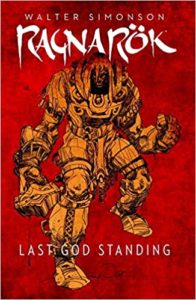 You don’t get opportunities like this very often. When you get a chance to speak to one of the literal legends of the comic book industry, you don’t waste any of it. In our phone conversation, Walter Simonson was gracious and forthcoming, expounding on his past and his present, some of inside-ball involved with making comics (especially comics with properties owned by film and television studios), and a lot about how he got to this particular moment…
You don’t get opportunities like this very often. When you get a chance to speak to one of the literal legends of the comic book industry, you don’t waste any of it. In our phone conversation, Walter Simonson was gracious and forthcoming, expounding on his past and his present, some of inside-ball involved with making comics (especially comics with properties owned by film and television studios), and a lot about how he got to this particular moment…
…That is, the conclusion of the second arc of his epic series Ragnarok. If that sounds familiar, it might be for the wrong reasons, but let’s clarify. In Norse myth, Ragnarok is the twilight of the gods, the war of the powers, and this concept has been an element of every story concerning the Norse god Thor for centuries, and in Marvel Comics’ reinterpretation of Thor as a superhero.
In fact, Walter Simonson is considered the creative force behind one of the series’ greatest eras. His kinetic panels and fast-paced writing gave comics fans a movie within a comic book, month after month (which is convenient, as Simonson was the go-to guy for movie adaptations for a period of time). Recently, in collaboration with IDW Publishing, he has revisited the character of Thor (not the Marvel version), an undead god roaming the world after the great battle was over.
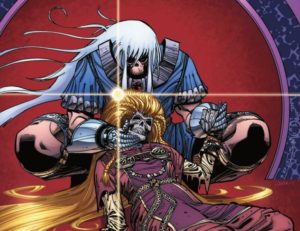 The conversation lasted nearly two hours, and in that time, Simonson spun fascinating tale after fascinating tale, which made the comics fan in me absolutely giddy, but made the editor in me extremely nervous. What to cut?
The conversation lasted nearly two hours, and in that time, Simonson spun fascinating tale after fascinating tale, which made the comics fan in me absolutely giddy, but made the editor in me extremely nervous. What to cut?
In the end, there’s far too much that’s good to leave on the editor bay floor. Instead, Popdose will bring you three installments of the interview, later focusing on the adaptations and the early years. This time out, let’s focus on Ragnarok, Thor, and Simonson’s obvious love for these mythologies.
Regarding the pace at which Ragnarok is hitting comic store shelves, Simonson is a bit…peeved.
I only wish I were faster. I’d like to put out issues faster than I am now, but on the other hand, I want them to look as good as they can. I kind of struck a balance between my age and my speed, but I’m very happy with the way it’s coming out. I’m enjoying it.
I like the research. I get to read a lot of stuff and figure things out, finding new books, pamphlets and whatever on Norse mythology, and I get to dig into them and hopefully find a different way to tell those stories. There’s no need to retell the original stories: you can go to the bookstore and buy those already! But I use all this information for background.
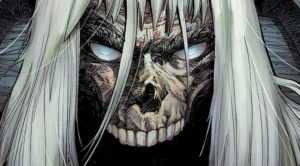 Was IDW always the home for Ragnarok or did you shop it around?
Was IDW always the home for Ragnarok or did you shop it around?
It wasn’t shopped around, but the story behind it is kind of different. My editor, Scott Dunbier, is an old friend of mine. We were pals long before he was editing comics — he was an art dealer back in the day. But around eighteen years ago, he was an editor at Wildstorm Comics. I think it was his first editorial gig and working for Jim (Lee). I was working either for Marvel or DC at the time, and Scott called me up. He asked if i had any interest in a creator-owned comic about the Norse myths, seeing how I liked that stuff.
I said, yeah, sounds great. I’ll finish up my current work and get back to you…Fifteen years later!
So now it is fifteen years later (being around five years before now), and I did a drawing of Thor, just for me. It wasn’t meant to be a precise Viking rendition, it wasn’t Marvel’s Thor. Just for me, just for fun, and I let it go. Then, sometime after that, I was driving somewhere, not too far from home, and I was struck by a thought. That drawing came back to mind and I had the idea for what turned out to be the first issue of Ragnarok. It wasn’t the complete story, but it was this idea that Thor was imprisoned and was not present at this Ragnarok. Thor would be a survivor because he wasn’t at the battle plain where the great fight took place. I knew that if I didn’t go home and write it down, I wouldn’t remember it. I turned around from my errands, came back, and typed for an hour.
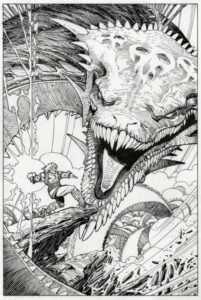 That became, maybe, issues one and a half. I had no idea what this meant, what this world was like that Thor was returning to, and I’m not dead certain I had the idea that this was after ragnarok, but the thought really was of Thor being imprisoned for a long time, and then escaping in some way. I had several scenarios worked out, including one where Thor is confronted by Loki, who is trying to kill him.
That became, maybe, issues one and a half. I had no idea what this meant, what this world was like that Thor was returning to, and I’m not dead certain I had the idea that this was after ragnarok, but the thought really was of Thor being imprisoned for a long time, and then escaping in some way. I had several scenarios worked out, including one where Thor is confronted by Loki, who is trying to kill him.
I don’t think it is giving away too much to say that Thor is indeed imprisoned, but that he kind of died during the imprisonment (even though only one god can truly kill another god). So his escape is, in part, a resurrection.
Some time later, probably a few months later, I was struck by a lightning bolt. I thought, holy cow, it’s after Ragnarok. That’s when it really began to turn into both a story I thought I could tell and a world in which the story could take place. The post-Great Battle stage was the genesis for a lot of what’s going on in the book. I got a hold of Scott, who was by this time with IDW, told him what I’d come up with, and he was keen to do it. We worked out a scenario and I began doing the comic book.
The third Marvel movie featuring Thor is called Thor: Ragnarok. You’ve been at this version of your story for a few years now. Are you concerned about the overlap?
Oh, no! Maybe it will help me sell a few more copies (and hopefully readers aren’t disappointed it’s not the movie)! (Laughs.)
 The thing about Thor — and it’s not just true for me but also for Roy Thomas and the other writers who have done Thor — the story of Ragnarok, the doom of the powers, or the twilight of the gods is a very powerful story. Most of it is contained in a very short poem, Voluspa, which is part of the Poetic Edda, an anonymous collection of poems by different authors. Somebody stitched a couple dozen or so of them together into a single document; about half of (the poems) had to do with the gods, and half had to do with mortals. This is one of the principle sources of information about the Norse myth.
The thing about Thor — and it’s not just true for me but also for Roy Thomas and the other writers who have done Thor — the story of Ragnarok, the doom of the powers, or the twilight of the gods is a very powerful story. Most of it is contained in a very short poem, Voluspa, which is part of the Poetic Edda, an anonymous collection of poems by different authors. Somebody stitched a couple dozen or so of them together into a single document; about half of (the poems) had to do with the gods, and half had to do with mortals. This is one of the principle sources of information about the Norse myth.
Voluspa is really the story of creation and destruction — the beginning and the end of the world — in one poem. It has a resonance for people that read it, so the writers of Thor at Marvel, myself included, often did some Ragnarok-based stories. In fact, I did it twice over the three and a half years that I was on the book. One of those times, I had Thor fight the Midgard serpent. Roy did a whole cycle with Odin’s eye and the rebirth of the universe. If you do Thor, you come around to that story eventually.
I have no idea what Marvel Studios are going to do in the film. I haven’t talked to anyone connected to the movie about what the story is or what it will be about.
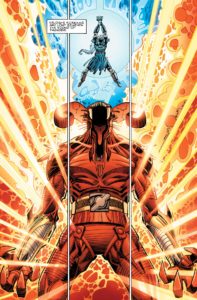 You obviously have a deep love for this. Where did that come from?
You obviously have a deep love for this. Where did that come from?
When I was a kid, my dad had a modest library of books, and my brother and I had free rein to read whatever we wanted to. I should have read more of them, honestly! He has a set of two little hardcover books — one of which was about the Greek and Roman myths, and the other about the Norse myths — called Myths of Northern Lands by H.A. Guerber. Its initial print was 1895, but it has been reprinted a few times since.
It had these great tonal illustrations that were very lovely, although the gods were dressed in very Greek kinds of outfits. They had the horned helmets but, overall, were very much in the “fantasy gods” vein. That book had quotations from the Elder Edda, and was really riveting.
I also recall being taken by a rendition of Beowulf I came across in school. It was a young-readers version of it, but I really loved it.
And I don’t know if this other piece has anything to do with it or not, but my grandparents on my father’s side emigrated to the United States from Norway. At least half of my background goes back to Scandinavia, but I’m not about to say that my love for Norse mythology is genetic.
Come to think of it, there was another book I remembered from my childhood. It was an oversized Golden Book. It was not like one of the “Big Little Books” they were known for. This was a retelling of the Iliad and the Odyssey by the husband and wife team of Alice and Martin Provensen. They did beautiful work. The art was inspired by Greek vases and was very “flat,” very textural, graphic, and abstract.
While it is not a part of those stories, the Provensens added a chapter at the end of their book about the Trojan horse. That actually came from the Aeneid because the Iliad doesn’t end with the fall of Troy. It ends with the funeral for Hector.
All of this kind of stuff — legends, myths, and lore — I’ve always loved these kinds of stories, and the Norse myths fit right in with that.
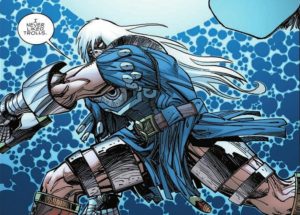 So circling back, how did you connect with Marvel’s Thor?
So circling back, how did you connect with Marvel’s Thor?
I was in college — this would be in 1965 — when I stumbled across my first copy of Journey Into Mystery from Marvel, issue 113, which contained a Thor story. It was “Return of the Gray Gargoyle.” My friend had a copy of it, and I’d never seen anything quite like it. I’d never seen a Marvel comic before that time, but had seen some of their precursor, Atlas Comics, back in the 1950s when they focused on monster stories. I wasn’t focused on superheroes. I read all kinds of comics as a kid, whatever I could get my hands on. At that time, I didn’t make the connection between Atlas and Marvel.
The 16-page story was done by Jack Kirby and Chic Stone. It was kind of a rough-hewn, energetic, lightly-written and bouncy piece with a lot of nice characterization going on…not a long story, but it crammed quite a bit into it. I was wowed by it. The idea that there was a comic about Thor just blew my brains out.
I was living on the East Coast at that time and Marvel Comics weren’t as widely distributed (as DC), so it was hard to find them. And they were coveted by the small audience that knew about them, so if you weren’t at the newsstand on Tuesday morning, the day they showed up, by Wednesday morning all the Marvel Comics were gone.
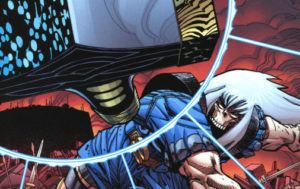 With all of this history and collected knowledge, how does this impact Walter Simonson’s Ragnarok?
With all of this history and collected knowledge, how does this impact Walter Simonson’s Ragnarok?
In my own comic, I’m not trying to do a precise adaptation of Viking culture, but I am trying to use Viking culture, Viking costuming, and so on as the basis for what I’m doing. I’m willing to step out and go farther into the depths of what the myths provide if I get inspired to do so. For the moment, these help provide the stage for the unique story I’m trying to tell.
It’s nice now (to do research) because of the Internet. It gives me a lot to look at. There’s more available to me now than even thirty years ago when I was doing Marvel’s Thor. It would have been so much harder then to find all of this material, so I now have access to such an incredibly rich resource.
I find it all very inspiring, really, to come across something I can use in the comic book.
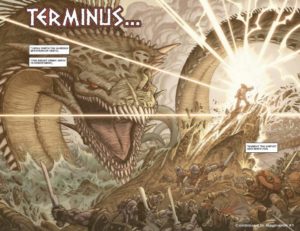 Thanks again to Walter Simonson for being so gracious with his time. The next installment of this series focuses on Simonson’s storied adaptations and continuations of movie and television properties like Star Wars, Raiders of the Lost Ark, Alien, and Close Encounters of the First Kind. You’ll also learn of the tale of the movie studio that repossessed a bunch of napkins. If you think we’re kidding, be back here for part two and get the whole story.
Thanks again to Walter Simonson for being so gracious with his time. The next installment of this series focuses on Simonson’s storied adaptations and continuations of movie and television properties like Star Wars, Raiders of the Lost Ark, Alien, and Close Encounters of the First Kind. You’ll also learn of the tale of the movie studio that repossessed a bunch of napkins. If you think we’re kidding, be back here for part two and get the whole story.
Walter Simonson’s Ragnarok is available at Amazon.com. You can learn more about the series at the IDW Publishing website.





Comments